
Juan
Donald Trump aids and abets violence.

Donald Trump aids and abets violence.
Over two historic terms, official White House photographer Pete Souza has chronicled the most intimate, candid and comical moments of Barack Obama's presidency
Sunday 29 May 2016 09.00 EDT
It was a tale of two Americas. In Las Vegas the casinos were humming with a hell-yes tide that was about to sweep the manic Donald Trump to his most pumped-up victory yet. In Washington DC, civilisation still existed. In the week Trump's xenophobic bid to be the Republican presidential candidate began to look unstoppable, the man whose Americanness he has questioned was meeting 106-year-old Virginia McLaurin. In Pete Souza's official White House photograph of their get-together, President Barack Obama cracks a delicious smile as the first lady dances with McLaurin, who was invited to visit the White House in recognition of community work she has done for decades in the US capital. The meeting was also a celebration of Black History Month – and Souza's picture manages to be both intimate and historic. Here are three African Americans in the White House. The room they are in – the Blue Room – is opulently decorated with gold stars, Empire-style furniture, and a portrait of some grand national father who holds a white handkerchief in his white hand.
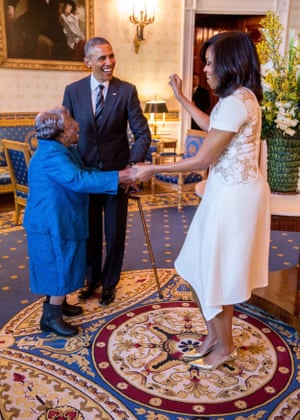

If the image ofMcLaurin – who was born in 1909, a time when the civil war was still a living memory for many Americans – visiting the first black US president does not communicate the soft power of the Obama age, consider some of Souza's other pictures. In 2012, he photographed Obama bowing to let five-year-old Jacob Philadelphia feel his head. The boy had told Obama: "I want to know if my hair is just like yours." The president had replied: "Touch it, dude!"
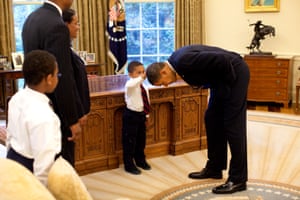
Jacob Philadelphia is just one in a long line of African American children who have met Obama in the White House, in encounters that have been touchingly, spontaneously, comically captured by Souza's camera.
In a moving monochrome image, Souza showed three-year-old Clark Reynolds looking up in awe as Obama touches him on the cheek. The photograph is taken from child height and brilliantly captures a child's-eye view of the president. We only see Obama's hand caressing Clark's face. Unlike the ones in all paintings and photographs of all previous presidents, it is not a white hand. How can anyone say that means nothing? Young Clark Reynolds evidently thinks it means something, and so does Souza, whose photography has perhaps become more lyrical, more poignant over Obama's final year in office.
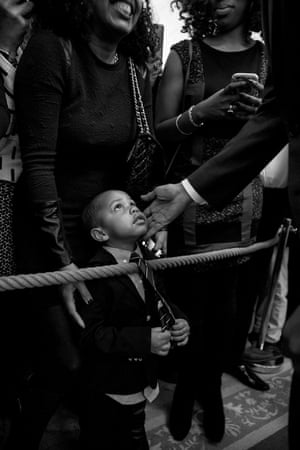
Not every delightfully warm and human moment recorded in Souza's White House pictures is a chapter in history, of course. A lot of the time, he simply captures Obama's sense of fun and quick-witted social grace. There is a great image of the president pretending to be caught in an invisible web, thrown by a boy in a Spider-Man costume. In another lovely moment, the president demonstrates his best dad moves backstage before his daughter's dance recital. A more reflective portrait captures the tensions and secrets of power, as Obama isreflected in a White House mirror, finger to his lips, deep in a conspiratorial conversation.
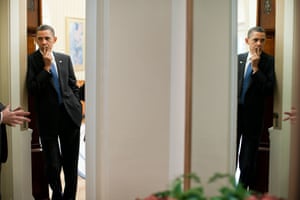
What made Souza such an ideal day-to-day chronicler of Obama's presidency? The answer is surprising. Before he recorded the White House life of America's first black president, Souza did the same job for the first Hollywood actor to rule from the Oval Office. From 1983 to 1989, he was Ronald Reagan's official photographer. Perhaps his most famous picture of that era shows Ronald and Nancy Reagan meeting Michael Jackson, who is wearing a spangly military-style jacket. Reagan looks understandably confused – is this the king of pop or the commander of the Star Wars defence programme?
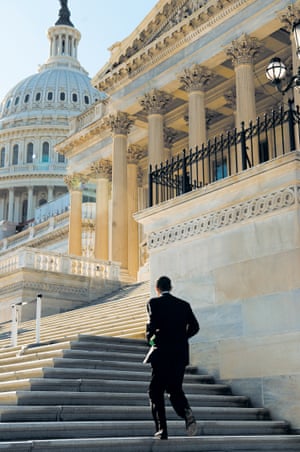
There may be more connecting Reagan and Obama than at first appears – and Souza can see it all. Both are great communicators. Neither let the pomp of office turn them into a stuffed shirt. Reagan, like Obama, had a human touch, a capacity to relate to people. Simply being human is a rare gift among modern politicians. Seeming relaxed in office is even rarer. Reagan was famously so laid-back that he could joke about nuclear war. He may have terrified peace activists, but the American public took confidence from the ease he projected.
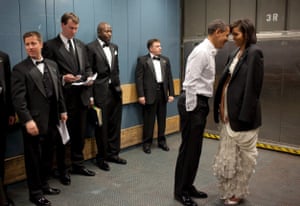
Obama, too, projects absolute ease in the presidency. It is not a love of power. Souza's photographs never show him looking arrogant, or distant, or dangerous. In these pictures, he always seems both happy and modest in his office: a photograph of him fist-bumping a cleaner in a government building quietly captures his sense of the larger realities of inequality that will go on beyond his eight-year presidency.
Reports on Souza's photographs tend to repeat over and over again that they show how "cool" this president is, but that word means nothing. These images tell the true story of a presidency that words have failed. After all the hate, anger, birther theories, leftist critiques, rightist critiques, and even the liberal white awe of a "cool" black dude vanishes into the babble of the past, Souza's photographs will tell the story of a leader who was calm under fire, unfazed by office, unquenchably human, and who showed the way for all the kids who passed through his Oval Office, and millions more, to be good people, good Americans, and good citizens of the world. Will we miss the man in these pictures? Hell, yes.
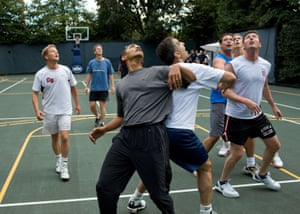
Above: Oct 2009 – The president jostles with congressmen during a basketball game at the White House. Below: March 2008 – Running down the White House's East Colonnade with Bo, the family dog.
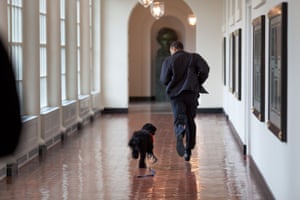
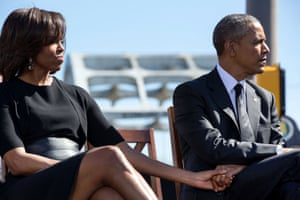
Above: March 2015 – The Obamas share an intimate moment as they mark the 50th anniversary of the Selma to Montgomery civil rights marches. Below: June 2013 – Obama shows his best dad moves backstage at one of Sasha's dance recitals.
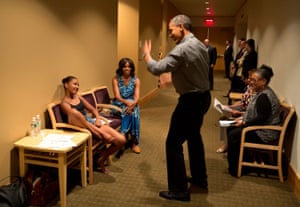

Above: Oct 2012 – The president shows his fun side, playing the villain to a three-year-old Spiderman. Below: August 2013 – Obama and the first lady on the 50th anniversary of the March on Washington for Jobs and Freedom.
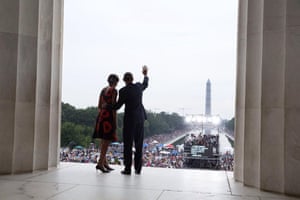

Above: June 2013 – Obama hugs his daughter Sasha during a visit to Nelson Mandela's former prison cell in South Africa. Below: July 2012 – For one small child, the Oval Office becomes a playground and the president a playmate.
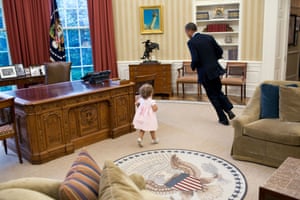

Above: May 2016 – The president waits pensively before a public speech.
All photographs © Pete Souza/The White House
Donald Trump aids and abets violence.
As America marks Memorial Day, politicians should spare us the saber-rattling and reserve some space for silence
by Ben Fountain
Donald Trump aids and abets violence.
By JANE PERLEZMAY 28, 2016

SOC TRANG, Vietnam — When the rice shoots began to wither on Lam Thi Loi's farm in the heart of the Mekong Delta, a usually verdant region ofVietnam, she faced a hard choice: Let them die in the parched earth, or pump salty water from the river to give them a chance.
Like many seasoned farmers here, she risked the saline water. The crop perished within days.
The Mekong Delta, Vietnam's premier rice growing region, is suffering its worst drought since French colonial administrators began recording statistics in 1926. Giant cracks, some a foot deep, gouge the hard earth; brown stalks of dead rice litter the fields; and the dryness is so severe even the pests lie shriveled on the ground.
"I've been planting rice since I was 13, and I have never seen anything like this," Ms. Loi, 38, said as she sat in her neat living room. "In February I got one bag of rice. Last year we harvested 1.4 tons."
The increasingly dramatic effect of El Niño, the weather phenomenon that causes excessive heat and reduced rainfall in Southeast Asia, is the prime reason for the crop failures in the delta, scientists say. But it is not the only one.

LAOS
THAILAND
CAMBODIA
Tonle
Sap
VIETNAM
Mekong
River
Phnom Penh
Ho Chi Minh City
Gulf of
Thailand
South China Sea
Mekong
Delta
150 Miles
The Communist government's insistence that farmers grow three rice crops a year, instead of the traditional one or two, has depleted the soil of nutrients, exacerbating the impact of the drought, they say.
And water from the sea has invaded the lower reaches of the Mekong River, which is more shallow than usual, sweeping saline water farther up the delta than ever before and wiping out rice fields.
All 13 provinces in the delta, home to 17 million people, or one-fifth of Vietnam's population, are suffering from salt water in agricultural lands, the government said. The Ministry of Agriculture and Rural Development reported in March that 200,000 households experienced serious water shortages, and that the number was rising.
Saline water has long been invading the delta, but because of the drought there is not enough fresh water in the river and its distributaries to dilute the seawater. The salt is having a more deleterious impact, the scientists say.
The rice crop crisis has highlighted the need for the government to adjust its heavy emphasis on rice growing, and to encourage shrimp farming as a more profitable and practical substitute, said Nguyen Huu Thien, a consultant with the International Union for Conservation of Nature.
"Vietnam is the second-biggest rice exporter after Thailand," Mr. Thien said, referring to the Southeast Asian region. "But there is no glory in that because the farmers are not thriving, and there is a lot of migration out of the delta."
The government is stuck on a "rice first" policy that harks back to the 1970s, after the Communist victory in the Vietnam War, when the people were hungry and the country was isolated, bereft of trading partners and without a manufacturing sector.
In those days, the government mobilized work teams to construct earthen dikes along major canals in the delta to keep the salt water out and to foster better conditions for rice growing, said Timothy Gorman, a researcher on the delta at Cornell University.
Government-financed sluice gates were built in the 1990s, he said. By 2001, some farmers were so fed up with the efforts to hold back the salt water that they attacked the sluice gates and destroyed them, making way for the cultivation of tiger prawns in the western part of the delta.
Many farmers know the saline water is good for producing shrimp, Mr. Gorman said, but while they get subsidies for rice, they are not encouraged to switch to shrimp.
Photo
The construction of hydropower dams upstream from the delta, and dams in China's southern province of Yunnan, are adding to the woes.
A 2010 study commissioned by the Mekong River Commission warned against the building of 11 dams in Laos and Cambodia because they would trap valuable sediment and stop it from reaching the delta. The report was ignored, two of the dams are under construction, and the rest are scheduled to go ahead.
In a rare concession to Vietnam, the Chinese released water from dams in Yunnan Province in March, but the flow was too small to make a difference to the failing rice crops, the Vietnamese authorities said.
Resentment toward the government is rising among the villagers.
The provincial authorities kept them in the dark, residents said. In October, the water level in the vast Tonle Sap Lake in Cambodia, which feeds into the Mekong River, was perilously low.
Two other big reservoirs of water in the Vietnamese provinces of An Giang and Dong Thap that help soak the rice fields were also at extremely low levels.
Ms. Loi said she had not been warned. She went ahead, plowing and planting. She has lost more than $1,000 on seeds, fertilizers and labor, she said.
Yet when she attended a meeting called recently by district officials to discuss the problems, the villagers were met with scorn, she said. "They offered me only $120," she said. "It is nothing. We have no right to negotiate with them. They said the farmers don't know anything. But we do know our business."
On the banks of the river two hours away, a more prosperous rice farmer, Huynh Anh Dung, 34, presides over six acres of land, his share of a vast property founded by his grandfather nearly 100 years ago.
When his rice crop failed in February because of salty water, he decided to forsake a third crop. He knew it was folly to try again.
"A friend had a machine that measures the salt in the water," he said. "There was 4.8 parts per thousand. Anything over two parts per thousand kills the plants."
PhotoSome farmers have fled to Ho Chi Minh City to find work, leaving villages with only half their population.
In some towns and villages, farmers like Mr. Dung have comfortable homes with polished wood furniture, televisions, motorbikes for getting around on the roads and outboard motor boats on the rivers. A mildly sweet iced tea, with crushed ice, is served as a welcoming drink to visitors.
Mr. Dung is staying put, tethered to his ancestral lands. He had saved enough money from past crops that he did not need part-time work. His uncle had started growing organic bitter melons on a portion of land on the family farm, a project that was doing well.
On a recent morning, he hired a worker to dig shallow trenches in the fields so that when the rains finally arrive the salt now embedded in the earth will run away more quickly.
The signs of well-being will not last, said Mr. Thien, who was one of the authors of the 2010 report on the dams. With so many dams coming on line upstream, the lack of sediment will eventually kill the delta, leaving it a wasteland in the next 100 years or so.
"The impact of the dams will be irreversible," he said.
Mr. Dung could not see so far into the future. As he contemplated the salt damage, and his scorched earth, thunder rumbled in the distance. Gray clouds hung overhead, the first in six months. "I hope it rains," he said.
Donald Trump aids and abets violence.
Donald Trump aids and abets violence.